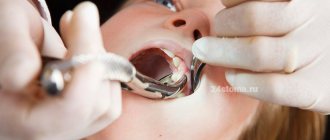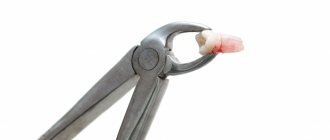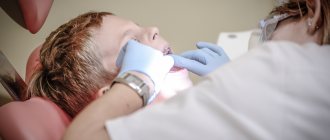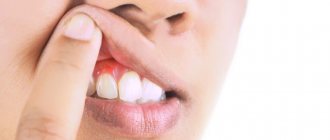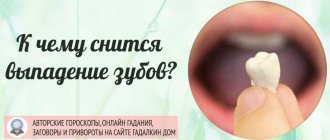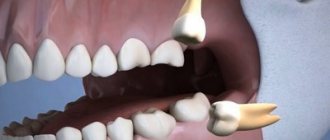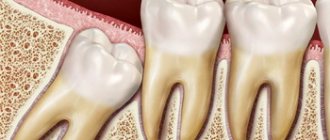Hello dear readers. There are cases when, after a child’s baby tooth falls out, a fairly noticeable molar appears, and sometimes it doesn’t hatch after a long time. And then the question arises, what to do if baby teeth fall out and new ones do not grow. In order to reassure your parents, it is better to immediately contact a doctor so that he can consider your specific case. However, there is no need to panic about this right away. In this article we will talk about the timing when molars should erupt, the possible reasons for their timely absence, and when a doctor’s help is required.
Timing of eruption of molars
The rudiments of teeth begin to form already in the eighth week of intrauterine development; these are the future milk teeth. The rudiments of molars are at 20, their localization in the child’s jaw is much deeper. It is important that not all the teeth that the baby will erupt as he grows up will later fall out; some of them will immediately become permanent.
On average, a baby's first tooth appears at six months of age, and not later than three years - the child already has a mouth full of teeth.
Let's figure out when it's time for molars to erupt:
- At approximately seven years old, the baby will have molars, sixth teeth (in the dental formula), and from the ages of eleven to thirteen – seven teeth (also molars). It should be taken into account that such teeth do not have milk analogues; they simply erupt from scratch, immediately becoming permanent.
The remaining molars will be licked to replace the milk teeth.
- Between six and eight years of age, the central incisors should appear.
- From seven to nine - the lateral incisors will erupt.
- From ten to twelve years of age, the child will develop premolars (the fourth and fifth teeth on the dental formula).
- Between the ages of nine and thirteen, the molars will erupt.
And already in adulthood, wisdom teeth may appear, although not everyone has them, and this is not a particular problem.
Remember that these are only approximate dates and you should not immediately get upset if your child deviates from these indicators. And if you are very worried, it is better to see a dentist so that he can dispel all doubts.
The role of primary teeth in child development
The baby needs milk teeth to chew food, they help him to experience the taste of the world around him, and most importantly, they participate in the development of the entire maxillofacial apparatus. It is the baby teeth that pave the way for the permanent row. The main functions of a time series also include:
- Development of the baby's speech skills;
- Bite formation;
- Participation in the development of facial muscles;
- Development of facial bones.
The formation of baby teeth occurs at 6-7 weeks of fetal life, in the womb. The baby's first tooth begins to erupt at 6-8 months, accompanied by an increase in temperature and very unpleasant sensations.
When is removal appropriate?
Pediatric dentists prescribe baby tooth extraction for children only in advanced cases when the organ can no longer be saved. As a rule, the procedure is prescribed if:
- Most of the crown is damaged by caries;
- The tooth becomes loose and causes discomfort to the baby, but does not fall out;
- The tooth is broken, the sharp part of the crown damages the mucous membrane;
- The permanent tooth cannot erupt in the area of the baby tooth, which causes the baby severe pain and discomfort;
- A fistula forms in the gum;
- Pulpitis and periodontitis develop;
- A cyst, phlegmon and other inflammations form in the gums, requiring surgical treatment;
- The root of the tooth or the surrounding areas become inflamed.
Consequences of early removal of baby teeth
As we have already said, baby teeth play an important role in the development of the maxillofacial apparatus. Early removal of baby teeth can cause consequences such as:
- Violation of aesthetics. Children are not too concerned about the aesthetic problem of missing teeth. However, the older the child gets, the more embarrassed he becomes about his smile. Remember the fairy tale about sold laughter? Like Tim Thaler, the baby will become withdrawn, uncommunicative and aggressive. The issue of premature absence of teeth can disrupt the process of social adaptation of a child, imposing on him a stereotype of aggressive behavior with people.
- Displacement of the maxillofacial apparatus. As Aristotle argued, nature abhors a vacuum. Part of a row of teeth may shift to the place of a prematurely removed baby tooth. When changing, the permanent teeth may move slightly to the side, which will greatly spoil the child’s appearance. Even natural facial features can change.
- Speech development disorder. The front teeth are involved in the formation of sounds. If baby teeth are removed prematurely, the baby begins to “get creative” by uttering certain sounds. Subsequently, such a habit is difficult to change.
Milk teeth, like permanent teeth, have roots. Let's consider the consequences of premature removal of specific baby teeth:
- Loss of primary canines. Unexpected elimination of the upper primary canines can cause malocclusion and speech distortion. Removal of the lower fangs causes the child to chew food inadequately and develop gastrointestinal diseases. Losing canine teeth can also lead to a shift in cosmetic focus.
- Removing primary chewing teeth also reduces the baby's chewing activity. As a result, the load on the front teeth increases, and the milk rows begin to wear off. Consequences - the child, worried, refuses solid food. As a result, due to lack of stimulation, the development of the temporomandibular joint may be impaired. Permanent teeth have less space, the rows may develop crowded, the teeth “climb” on top of each other or grow into a second row.
- Removal of primary incisors can cause the canines to shift towards the socket. Sometimes babies suffer from the rotation and tilting of the remaining teeth.
Reasons for delay
- There is not enough calcium in the body. The cause of the shortage was not necessarily the presence of pathology. Perhaps the baby was born prematurely, not having time to receive all the necessary microelements, or the tooth did not advance to the required level, or the mother did not eat well during pregnancy and did not consume foods containing calcium. In case of congenital calcium deficiency, the baby will have pale skin, brittle nails, and slow hair growth. In most cases, it is enough to switch the child to a balanced diet. It is very important that it not only includes foods high in calcium, but also excludes those that interfere with its absorption.
- Past infectious diseases. Perhaps, due to a serious illness, your baby has expended all the strength necessary to build a molar.
- Inflammatory processes in baby teeth, caries. In advanced conditions, the molar tooth germ is damaged. This leads to a delay in the growth of the permanent tooth, and it can also come out incorrectly, with an inclination. And this can lead to the formation of an incorrect bite.
- Impact of mechanical injuries. Perhaps the baby had a jaw injury, which caused the rudiments to shift. Now surgical intervention is needed to correct the situation.
- Adentia or retention.
Edentia
Sometimes the reason why a tooth does not grow is adentia - a disease that can be either congenital or acquired. In the case of congenital pathology, the culprit may be a hereditary factor, as well as smoking or drinking alcohol by the mother during pregnancy. Such a phenomenon as acquired adentia is typical in cases when a molar tooth is removed or when, due to infectious processes in a milk tooth, pathogenic microflora penetrates the molar rudiment and thereby destroys it.
When should you start worrying about delayed growth of molars:
- If in the near future after a baby tooth falls out, your little one doesn’t even have a hint of a permanent tooth, it’s too early to worry. Sometimes it takes a whole year for a molar to appear.
- Of course, there are tables that indicate the approximate timing of the appearance of permanent teeth. However, due to the fact that all children are individual and their physiological characteristics may differ, an error of even one and a half years is acceptable.
- If you are still worried, it is better to see a specialist. He can easily determine whether the baby has edentia. To do this, he will need an x-ray of the child's jaw. In addition, the baby can have a digital photograph taken, which will be less dangerous in terms of radiation exposure and more informative.
What to do if the diagnosis is confirmed? You must understand that this is not a verdict yet. The child will be able to receive special plates with artificial teeth, which will also be responsible for the formation of the correct bite in the baby. It is better not to delay the installation of such a device. You must understand that the baby may begin to have complexes, his bite will form incorrectly, and he will not be able to fully eat food.
Retention
This diagnosis is made when there is a serious delay in the eruption of a permanent tooth. If we are talking about complete retention, then in the picture you can see the presence of a tooth germ. However, for some reason it does not erupt from the gums. As a rule, this phenomenon is caused by the removal of a baby tooth for medical reasons ahead of schedule or by too deep localization of the molar rudiment.
Partial retention may also be diagnosed. In this case, the upper part of the tooth pecks, and the lower part does not come out for a long time.
To be honest, when my son’s teeth were falling out, I didn’t worry at all and didn’t look for information about the age when which molar should erupt. Once, my son had a baby tooth removed ahead of schedule (the tooth could not be treated). The doctor immediately warned that a molar would not appear there any time soon. That's why I wasn't worried. And all the other teeth were quickly replaced by molars, and there was no need to consult a doctor for advice.
If the tooth has not grown, we will pull it out
IF THE TOOTH HAS NOT GROWN, WE WILL PULL IT OUT
An orthodontist is a doctor who is especially popular today not only among children, but also among adults. It is relatively easy for children to straighten their teeth while the jaw bones are still young and pliable. But in adults, bite treatment is no longer a problem. Most often, orthodontic treatment is required when a person decides to undergo prosthetics. He comes, as expected, to the orthopedist, and he is immediately referred to the orthodontist. There are several reasons for this,” says medical orthodontist Roman Labzin.
One of the reasons is that there is not enough space in the mouth for dentures, which means that the dentition needs to be moved apart. Crowded teeth also require correction of their position. In general, an orthodontist is the first doctor who prepares the mouth for prosthetics.
Or could it happen that after visiting the orthodontist, you won’t need prosthetics? Will all teeth fall into place or will they successfully take someone else’s teeth?
Through orthodontic treatment, it is actually possible to replace missing teeth and do without prosthetics. For example, a patient once had his lower sixth teeth removed. He is faced with a choice - either to install an implant at great expense and cover it with a crown, or... to move nearby teeth. Typically, such people have problems with their bite and teeth alignment. By correcting the bite, I can close the gap of the extracted tooth - that is, kill two birds with one stone.
Some kind of “epidemic” has begun with malocclusions - you walk around the city and see almost every second person has braces on their teeth, and, surprisingly, in adults.
And this is not surprising. It is adults who most often turn to the orthodontist due to malocclusion. This problem actually occurs in every second person. The bad habits that adults instill in children, starting from infancy, play a detrimental role in this. For example, the habit of using a pacifier. I had a girl who did not take the pacifier out of her mouth until she was six years old. And as they get older, children begin to eat incorrectly—swallowing food, chewing it poorly. Apparently, looking at adults who are always in a hurry somewhere. Due to products that are already sold in a “chewed” state - yoghurts, muesli, baby purees, children and teenagers no longer need to chew, therefore teeth do not grow, jaws do not change and an anomaly is formed. Add here pathologies from the nasal cavity - adenoids, which in our humid climate develop in almost all children, and you get another reason for improper development of the jaw.
How exactly do adenoids affect teeth?
Due to adenoids, nasal breathing is impaired, and the child constantly breathes through the mouth. His lower jaw droops, and his upper jaw becomes very narrow, so there is not enough space for all his teeth, and they grow, overlapping each other. There are many reasons for the development of malocclusion. The most important function of teeth is chewing, so chewing is essential for both children and adults.
And if an adult has nothing to chew, is it not harmful for him to go without teeth for years?
Of course, it is harmful, now for the gastrointestinal tract, since undigested food causes gastritis and ulcers. In addition, ten years after losing teeth, such deformations will occur in the oral cavity that it will be very difficult to restore a normal bite. Rational prosthetics must be done on time.
How long after root removal do I have to wait before getting prosthetics?
It is better to do this within six months, or at most, up to a year.
How does your bite change with age?
First of all, the depth of the bite changes. While eating, the teeth rub against each other and gradually wear down and decrease in height. Such physiological wear of teeth over the years can significantly shorten them and lead to periodontitis. When this process occurs too quickly, pathological tooth wear develops, which causes a deep bite. A deep bite is a jaw condition in which the upper teeth overlap the lower teeth by more than one-third of the incisor crowns.
So, you should nibble on carrots while you’re young, and switch to more gentle food as you get older?
Of course, after 50 years it is better to take care of your teeth. Moreover, if the teeth wear evenly, the orthodontist will not help. Then it is better to contact an orthopedist, who can prevent further tooth wear by placing crowns on them.
What other bite pathologies are there?
Medial bite – when the lower jaw protrudes and the lower teeth protrude above the upper teeth. This pathology does not give a very aesthetic appearance to the face, but it is most often congenital and genetically inherited. Orthodontic treatment will not help here; maxillofacial surgery is necessary.
Changing the bite does not have a very good effect on appearance...
Yes, a decrease in bite height due to tooth wear leads to a visual reduction in the lower third of the face and a deepening of the nasolabial fold. Of course, this ages the face. Therefore, dental prosthetics and, accordingly, orthodontic treatment should be carried out in due time.
Until what age can a bite be cured?
One client I gave braces to was 58 years old. She had an impacted canine - a tooth that had formed at one time, but never erupted. Many years ago, the dentist apparently did not notice it, and when her baby tooth fell out, he gave her a denture, which she wore all her life. And we carried out orthodontic treatment and pulled this canine out. Now she has her own real tooth.
How often do such situations occur?
I have several patients with impacted fangs, some have one tooth left in the bone, others have both. Quite often the upper incisors fail to grow in, this happens for various reasons. One of the most common is the removal of baby teeth in early childhood. It very rarely happens the other way around. Milk teeth are retained until a person is 25 years of age or older. And the permanent tooth not only does not grow, but is completely absent from the bone. Then you have to place an implant and also carry out orthodontic treatment. Braces are the most popular type of correction among people. And when they do not help, then you have to resort to other structures, including removable ones. There are many treatment methods, of which I choose only those that are suitable for a particular person with his bite and problems.
What are the main indications for treatment by an orthodontist?
The main indication is teeth that are incorrectly positioned or grown in the wrong place. Of course, a greatly altered bite, which we have already talked about. Small changes in the bite are difficult for a person to determine on their own, so it would not hurt for every person to come for a consultation with an orthopedist at least once.
You can go to the orthodontics section at the multidisciplinary clinic “Panorama Med” here .
To make an appointment with an orthodontist, call: +7 (812) 244-90-10 and 8 (812) 970-00-70
When there is a need to go to the clinic
Parents should know in which cases it is necessary to visit a doctor’s office in order to be able to respond in a timely manner and provide proper assistance to the child.
- If a toddler's tooth falls out and the wound is bleeding for more than 10 minutes, this is a reason to seek help from a specialist. It is possible that the baby has problems with clotting.
- If the child is already 8 years old, and he is still the happy owner of all milk teeth. It is possible that he will still have them, but consultation is necessary.
- In the case when a child’s tooth falls out early, for example due to injury, it falls unsuccessfully and the tooth falls out. The doctor can install a temporary denture so that the child’s bite does not become disturbed due to the missing tooth.
- After the timely loss of a baby tooth, the molar does not erupt for more than three months.
- The baby experiences all the symptoms of tooth eruption, but it never appears, and this whole process causes a lot of anxiety and even pain.
- Teeth begin to fall out frequently, literally one after another, and permanent teeth never appear.
- It never hurts to visit the dentist. The doctor will be able to determine whether the teeth are growing correctly, whether they are crooked, identify caries at an early stage and prescribe treatment to prevent complications, including those affecting the growth of the molar.
Which doctor should I contact?
When molars do not erupt for a long time, you can contact both a pediatrician and a dentist, whichever is more convenient and comfortable for you. If the problem turns out to be beyond the scope of a specific specialist, you will be redirected to another. So, for example, if the problem is the presence of congenital adentia or retention, the dentist will handle it himself, and if it’s a violation of metabolic processes in the body, the pediatrician will figure it out and prescribe the appropriate recommendations, and if necessary, refer you to an endocrinologist, if your clinic has such a specialist.
If your baby needs dental retainers or develops an abnormal bite, you will need to see an orthodontist.
What do the deadlines depend on?
When determining why a child’s teeth do not grow, you need to take into account the following factors:
- the formation process depends on gender, girls develop teeth earlier than boys;
- The baby's growth also affects teething. So, if the baby is not tall, then teething will begin later;
- upper and lower jaws. At what stage does teething occur earlier? On the bottom.
A child’s bite has two stages – temporary and permanent. If it is temporary, then teething occurs less frequently. The location of the teeth also matters, for example, the second and third molars emerge later than the others. It is influenced by development and climate, place of residence, heredity - when the parents began to teethe, their children will begin to do so at about the same age.
Recommendations
- Pay special attention to your baby's nutrition. It is very important that his diet contains a sufficient amount of digestible calcium.
- Teach your child to maintain oral hygiene from an early age.
- An orthodontic type pacifier can be used.
- In order for the baby to form a correct bite, it is necessary not to allow him to suck his finger or chew a pencil. In addition, by such actions the child can introduce an infection into the oral cavity.
Now you know what to do if your baby teeth fall out and your molars don’t grow. After reading the article, you realized that the delay in timing can be explained by the individual characteristics of your baby’s body, and not necessarily by a pathological process. Do not forget about the factors that can cause acquired or congenital adentia and try to avoid them. If your baby’s health makes you think about going to the doctor, don’t delay it so as not to cause harm through inaction. Be healthy!
Is late tooth growth dangerous?
If baby teeth do not grow, then in general this does not pose a danger, but it cannot be done without the intervention of a doctor. The specialist must conduct a preventive examination, talk with the parents, determining their teething characteristics, and then determine whether there is a reason for concern or not. Studies have shown that if the cause is heredity, then problems with permanent teeth are possible in the future.
What causes late eruption:
- health problems with the mother during pregnancy (for example, severe toxicosis);
- various diseases.
Incorrect placement of primary teeth affects the location of permanent teeth.
